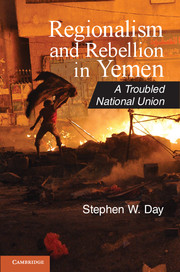Book contents
- Frontmatter
- Contents
- Tables
- Maps and Photos
- Preface
- Acknowledgments
- Abbreviations
- Chronology of Modern Yemeni History
- Glossary of Names of Key Political Figures
- Introduction
- 1 Understanding the Regional Divisions of Yemen
- 2 Two Revolutions, Two Republics
- 3 Salih Family Rules and the Sanhan Tribe
- 4 Unity in Name Only
- 5 The Spoils of Civil War
- 6 A Regime in Control?
- 7 Political Eruptions after 9/11
- 8 The Return of Yemeni Regionalism
- 9 Yemen’s Political Meltdown
- Conclusion
- Appendix
- Bibliography
- Index
1 - Understanding the Regional Divisions of Yemen
Published online by Cambridge University Press: 05 July 2012
- Frontmatter
- Contents
- Tables
- Maps and Photos
- Preface
- Acknowledgments
- Abbreviations
- Chronology of Modern Yemeni History
- Glossary of Names of Key Political Figures
- Introduction
- 1 Understanding the Regional Divisions of Yemen
- 2 Two Revolutions, Two Republics
- 3 Salih Family Rules and the Sanhan Tribe
- 4 Unity in Name Only
- 5 The Spoils of Civil War
- 6 A Regime in Control?
- 7 Political Eruptions after 9/11
- 8 The Return of Yemeni Regionalism
- 9 Yemen’s Political Meltdown
- Conclusion
- Appendix
- Bibliography
- Index
Summary
In 1990 the Yemeni people achieved national unification when leaders from the north and south agreed to merge, creating the Republic of Yemen. The negotiation of Yemeni unity in 1989 coincided with German unification at the end of the Cold War. Contrary to common thinking at the time, Yemen’s original territorial division was never part of Cold War politics. Unlike the twentieth-century political divide in Germany, as well as Korea and Vietnam, Yemen’s division preceded the superpower rivalries of the late 1940s and early 1950s. In fact, regional divisions on the southwest corner of the Arabian peninsula extend centuries back in time. Across history, territorial unity in Yemen is the exception rather than the rule.
Yemen’s north-south boundary line was drawn by cartographers and surveyors sent from the imperial capitals of London and Istanbul in the first decade of the twentieth century. Yet neither the British nor the Ottoman Empire exercised uniform power on its side of the border. This was true both before and after the early 1900s. It was also true during earlier centuries when Yemeni rulers governed prior to the arrival of British and Ottoman forces. There is a long legacy of divided rule in Yemen, since multiple authorities exercised power in small regions of the country separated by vast mountains, canyons, and desert sands. In the nineteenth and early twentieth centuries, the British signed treaties with more than twenty separate sultans and emirs who ruled areas of varying size in the south. The country’s rugged terrain, especially in the northwest mountains, gives Yemen a reputation as a difficult place to govern. Similar to the people of Afghanistan, Yemenis speak of their homeland as the “graveyard of empires.”
- Type
- Chapter
- Information
- Regionalism and Rebellion in YemenA Troubled National Union, pp. 22 - 55Publisher: Cambridge University PressPrint publication year: 2012
- 1
- Cited by



